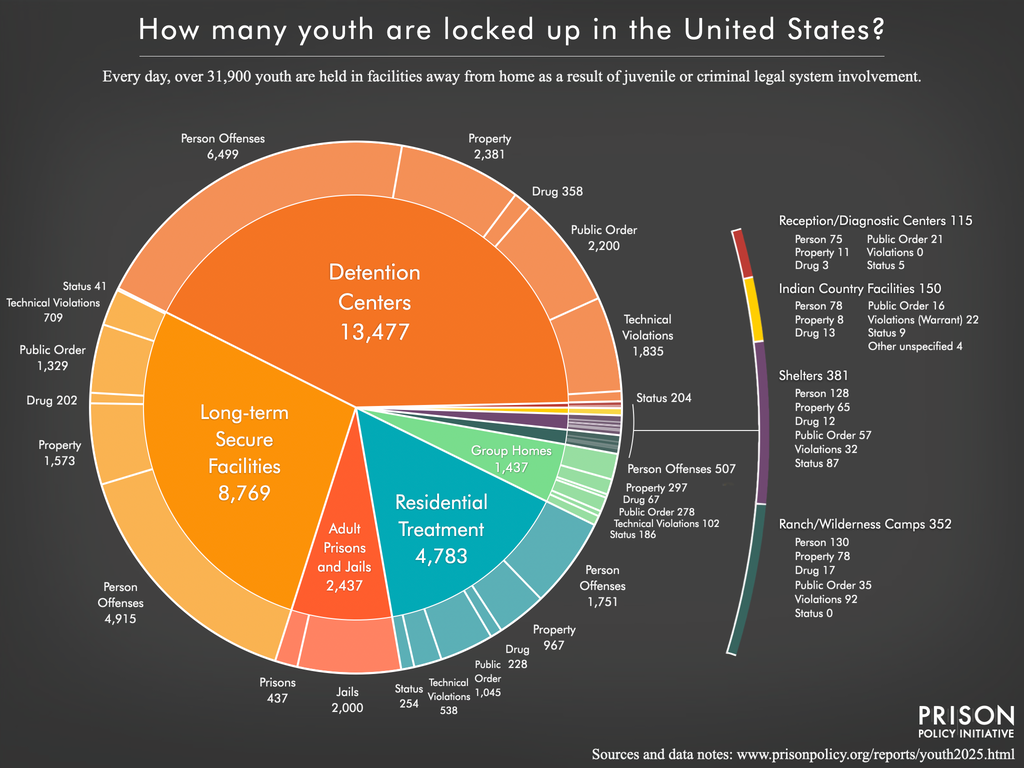A new report, Youth Confinement: The Whole Pie 2025, has laid bare the grim reality of America’s youth incarceration system. While the overall number of system-involved young people held in confinement has gone down in recent years, the findings reveal something deeply troubling: racial disparities are worsening. Black, Latino, and Indigenous youth remain far more likely to be locked up compared to their white peers, raising urgent questions about justice, equity, and the future of our communities.
The Numbers Are Down, But the Harm Remains

At first glance, it might seem like progress. Compared to the 1990s and early 2000s, when youth incarceration reached historic highs, the number of confined children today is significantly lower. However, the new Whole Pie report makes it clear that the drop in total numbers should not mask the ongoing and systemic problems within the system.
Even as fewer young people overall are being incarcerated, racial and ethnic minorities are disproportionately targeted, confined, and punished more harshly. This points to a justice system that has not dismantled its inequities but instead has concentrated its harshest treatment on the most marginalized communities.
Where Are These Children Being Held?
The report breaks down where youth are confined and under what conditions. While some are held in juvenile detention centers awaiting hearings, others are placed in long-term facilities resembling adult prisons, residential treatment centers, or boot camp–style programs. Conditions vary widely, but too often they include:
- Isolation practices that cause long-term psychological damage.
- Unsafe and unsanitary environments, where basic health and educational needs are ignored.
- Violence and abuse, both from peers and sometimes even staff, leaving lifelong scars.
The harsh truth is that many of these facilities are little more than prisons for children — and in some cases, they are literally tied to the same private prison industry that profits from mass incarceration.
What Are They Being Confined For?
Another critical finding of the Whole Pie 2025 report is that many young people are confined for low-level offenses or technical violations rather than serious crimes. In fact, a significant percentage of youth incarceration cases involve nonviolent conduct — things like truancy, probation violations, or running away from home.
This raises the pressing question: Why are we locking children away for behavior that often stems from poverty, trauma, or lack of community support? Rather than addressing root causes, the system too often defaults to punishment.
The Worsening Racial Gap
Perhaps the most alarming aspect of the report is its confirmation that racial disparities are not improving — they are worsening.
Black youth are more than four times as likely to be confined as white youth, even when charged with similar offenses. Latino and Indigenous youth also face disproportionate confinement rates. This reflects systemic biases at every stage of the juvenile justice process — from policing and charging decisions to sentencing and confinement.
Instead of serving as a rehabilitative system designed to help kids, the juvenile justice system continues to function as a pipeline into deeper criminalization, particularly for children of color.
Why This Matters
Youth confinement is not just a juvenile justice issue — it’s a moral, social, and economic one. Locking up children disrupts their education, severs family ties, and often sets them on a path of lifelong involvement with the criminal justice system.
The use of confinement also perpetuates cycles of poverty and inequality. By disproportionately targeting youth of color, the system entrenches racial injustice and deprives communities of their future leaders. Meanwhile, facilities tied to for-profit incarceration schemes reap financial benefits, exploiting children for revenue streams.
Toward a More Just Future
The Whole Pie 2025 report underscores the urgent need for reform. Advocates and organizations are calling for:
- Ending youth confinement for low-level and nonviolent offenses.
- Investing in community-based alternatives, such as mentoring, counseling, and restorative justice programs.
- Shutting down abusive facilities, especially those tied to private prison interests.
- Addressing racial disparities head-on, through policy reforms, accountability measures, and independent oversight.
True reform requires shifting resources away from incarceration and into education, healthcare, mental health services, and community programs that actually help young people thrive.
Final Thought
While the decline in overall youth incarceration numbers is a step in the right direction, Youth Confinement: The Whole Pie 2025 makes clear that the system remains deeply unjust. For too many children, especially those from marginalized communities, the promise of rehabilitation is replaced by punishment, isolation, and a lifetime of barriers.
If we are serious about building a fair and sustainable justice system, we must confront the racial inequities at the heart of youth confinement and dismantle the ties between juvenile justice and the profit-driven private prison system.
The future of countless children depends on it.

